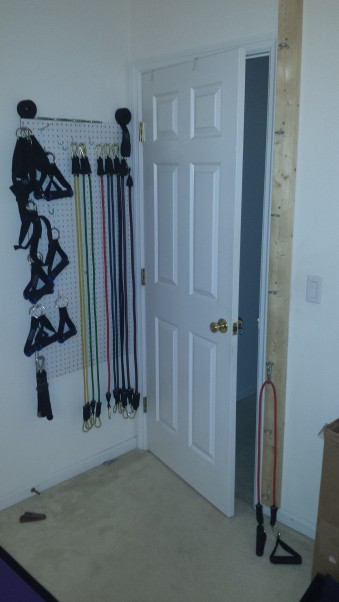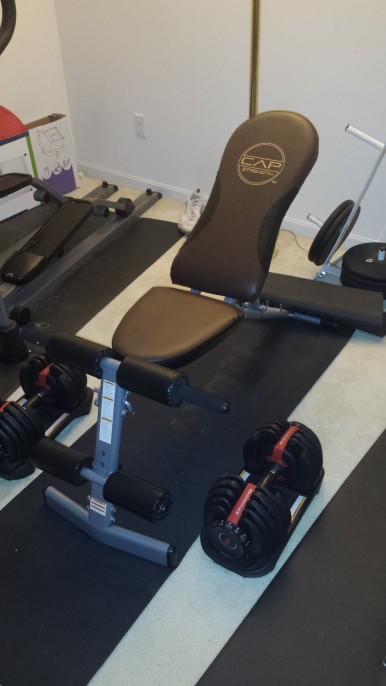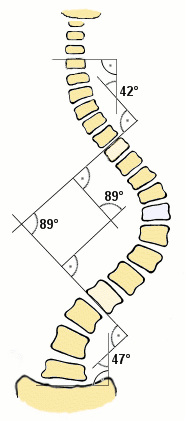Though our girls wear braces, we don’t put all our “stock” in these. We believe specific stretches and exercises can actually help the scoliosis. But, at a minimum, we think brace wearers should do some core strengthening just to offset the atrophy caused by bracing.
What follows is a look into our setup and approach.
To be sure, I’m not trying to suggest that all the items mentioned below are proven to work. We’re just trying whatever we can that seems to make intuitive sense to us. And, as per usual, I’m not a licensed practitioner of any kind. Seek professional advice!
Band Pulls
A staple of our exercise regimen, and very common therapy for back problems in general, is to pull exercise bands, like shown here (we primarily do the first type demonstrated in the prior link). Having had therapy for back issues of my own, though, I know it’s good to alternate the angle of the pull to target different areas of the back. So, I mounted a 2×4 that reaches floor to ceiling (screwed into a stud) and attached eyelets at about 1 foot intervals. The bands are then looped through Jensen Spring clips which can be easily moved from one level to another. As for the bands themselves, I bought a couple sets of Bodylastic bands then got some extra handles that are a better fit for the girls’ small hands.
Lat Machine
This is ideal for us because we get the lat pull-down without the footprint of the larger combo machines. I believe the lat pull-downs to be an excellent way of activating and strengthening the upper back and paraspinal muscles. Just start in the elongated position and bring down tightly to chest. I picked up several light weight plates, ranging from 1.5 to 10 pounds, at a used sports equipment store, making it easy for the girls to adjust the weight to what works for them. We target a reasonably challenging 15 to 20 reps per set. When 20 reps become easy, they slightly increase the weight.
Ed Paget Video
In addition to what I’ve described above, some of what we do with the bands and lat machine are based on the following video from Ed Paget. This, was actually my first “find” that got me started down the road of trying to help our daughters’ scoliosis through stretching and exercise. Thank you Ed!
Bench and Bowflex SelectTech dumbells
The SelectTech dumbells are Excellent! They start at 5 pounds and can be incremented by 2.5 pounds up to 25 before going to 5 pound increments. We do some bench/chest presses to provide balance (not good to only work the back muscles all the time without at least minimal chest work), as well as for doing back exercises by facing downward on the bench (incline of flat), and raising the weights up.
Schroth Wall Bars
The Wall bars, used for Schroth exercises, were the biggest expense. I bought these from InFitnessEquipment.com. They come as a kit which you assemble and attach to the wall. I chose to also install a mirror behind the wall bars as well as on the side walls, which facilitate the Schroth exercises. I recommend safety backing on the mirrors in case they get broken.
In addition to Schroth exercises, which we learned from Peter Arndt at Spinal Dynamics in Wisconsin, the side wall (low) mirrors are also good for allowing the girls to watch their form to help make sure they’re doing their side planks properly.
Vestibular/Stability Disc
Some believe standing on one of these inflatable balance disks and performing other tasks, like tossing a ball with someone or balancing something on your head, helps to condition and train your paraspinal muscles for subconscious, balanced support… So, we’re trying to mix some of this into our routine. We actually have two of these so the girls can stand on them and toss a ball or bean bag back and forth.
Exercise Balls
Also common for back therapy is to do exercises using Exercise Balls. These can be used for sitting leg raises, walk out bridges (back planks) and walk-out front planks. The instability added by doing these exercises on the balls helps to better engage all the muscles. Though not exact, ball exercises we’re doing are similar to the following:
Stretching: Elongation
These are obviously used for decompression/elongation. We try to use it a few minutes at a time about 3 days per week. Be gentle. One need not go full inversion to achieve the goal.
Stretching: Concavities
We also do some side-lying stretching for opening up the girls’ concavities. The best illustration of this I found online follows. This must be done very carefully, particularly for “S” curves. I’ve seen many illustrations where they show the entire body being arched to one side. While that may be great for a person with a single thorocolumbar curve, it likely exacerbates the compensatory lumbar curve for a person with an S curve who is doing this to stretch out her thoracic concavity. Note, in the below illustration, how the top leg is raised and upper hip brought cranially, to have a straightening effect (toward the floor) for the lumber curve while a bolster is used to move the thoracic curve toward the ceiling. We must assume the subject has a typical S curve (with the thoracic convexity on the right and lumber convexity on the left), for this to be effective.
For stretches like the above, it’s good to have an assortment of bolsters on hand.
Stretching: Hamstrings
More recently, I’ve read it is important to stretch out the hamstrings. To support the back while doing this, we lay on the floor near a door frame and leg up to 90 degrees (foot on door frame) then hold there as tolerated before switching to the other side and repeating.
Found a good illustration at Fitness-training-at-home.com
Sources/Costs
We didn’t spend much on most of this, other than the Schroth wallbars. Yard sales, Craigslist, and used sporting goods stores are your friend.
Track It!
I’ve heard it said in the project management world that “what doesn’t get measured, doesn’t get done.” I recommend making a spreadsheet of whatever exercises you intend to do and checking them off each date. Ideally, this spreadsheet has date columns so you can see what was done each day over time.
In Closing
This actually doesn’t cover all we do, but it does pretty well cover our setup. I’ll try to post more about other stretching and exercises in the future.
If anyone would like me to go into more details about any of the specific exercises, please comment accordingly and I’ll try to do so in a future post, or amend this one.
My Standard Disclaimer: I am not, in any way, medically trained and you should seek professional medical advice before making any decisions based on information found here.












I am impressed by your desire to learn and the efforts that you put forward.
LikeLike
Thank you, Patrick. That is very kind of you to say.
LikeLike
Hi! Do you mind if I reblog this post?
LikeLike
Hi! Not at all. Happy to have the information shared. Regards
LikeLiked by 1 person
Pingback: Therapy/Exercises: How to Be Sure They’re Done Without Nagging | lifehascurves